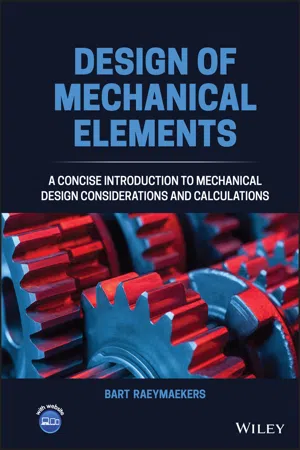Technology & Engineering
Shafts
Shafts are mechanical components used to transmit power and motion between different parts of a machine. They are typically cylindrical in shape and can be found in various types of machinery, such as engines, pumps, and conveyor systems. Shafts are designed to withstand torsional and bending forces, and they often have keyways, threads, or other features to connect them to other components.
Written by Perlego with AI-assistance
4 Key excerpts on "Shafts"
- eBook - ePub
- Wei Jiang(Author)
- 2019(Publication Date)
- Wiley(Publisher)
Shafts are important elements in virtually all types of machinery. They are supported by bearings, rotate and transmit power and thereby torque. A typical application of Shafts is input, output or intermediate Shafts supporting gears in gear reducers.Unlike standard elements, Shafts are designed for specific applications individually, considering the mounted elements, operating loads and service conditions. Power transmission elements, such as gears, belt pulleys, chain sprockets, couplings and so on are attached to the Shafts by keys, splines, pins and other devices. When Shafts rotate with power transmission elements, power and rotational motion are transmitted from one element to other rotating parts of shaft system [1 –3 ].10.1.2 Types of Shafts
A shaft is a long cylindrical element loaded torsionally, transversely and/or axially as a machine operates. Consequently, Shafts can be classified as transmission Shafts, axles and spindles according to the loads they carry [4] . Transmission Shafts carry both bending and torsional moments, and are usually stepped, as shown in Figure 10.1 a. They support gears, pulleys and so on and often transmit power. Axles carry bending moments only. They are used to support rotating wheels, pulleys and the like. An axle can turn with a wheel as a unit, like a railway car axle, as illustrated in Figure 10.1 b, or is nonrotating, like the axle of the front wheel of a bicycle. Spindles take torsional moments only, like the one in an automobile, as shown in Figure 10.1 c.Figure 10.1Types of Shafts classified by loading.According to the shapes of axis, Shafts include straight Shafts, with either different diameters or constant diameters and crankShafts. Stepped Shafts have different diameters and are usually used as transmission Shafts, while constant diameter Shafts work as axles or spindles. CrankShafts are used to convert reciprocating motion into rotary motion or vice versa. Most Shafts are solid and hollow Shafts are used to save on weight. Also, flexible Shafts are used to transmit power along a curved path when space is limited or the axes of the power source and driven machine are not aligned with each other, as shown in Figure 10.2 - eBook - ePub
Mechanical Engineering Design
Third Edition
- Ansel C. Ugural(Author)
- 2020(Publication Date)
- CRC Press(Publisher)
9 Shafts and Associated Parts9.1 Introduction
Shafts are used in a variety of ways in all types of mechanical equipment. A shaft , usually a slender member of round cross-section, rotates and transmits power or motion. However, a shaft can have a noncircular cross-section and need not be rotating. An axle , a nonrotating member that carries no torque, is used to support rotating members. A spindle designates a short shaft. A flexible shaft transmits motion between two points (e.g., motor and machine), where the rotational axes are at an angle with respect to one another. The customary shaft types are straight Shafts of constant or stepped cross-section and crankShafts (Figure 9.1 ). The former two carry rotating members such as gears, pulleys, grooved pulleys (sheaves), or other wheels. The latter are used to convert reciprocating motion into rotary motion or vice versa.FIGURE 9.1 Common shaft types: (a) constant diameter, (b) stepped, and (c) crankshaft.Most Shafts are under fluctuating loads of combined bending and torsion with various degrees of stress concentration. Many Shafts are not subjected to shock or impact loading; however, some applications arise where such load takes place (Section 9.5). Thus, the associated considerations of static strength, fatigue strength, and reliability play a significant role in shaft design. A shaft designed from the preceding viewpoint satisfies strength requirements. Usually, the shaft geometry is such that the diameter will be the variable used to satisfy the design. Of equal importance in design is the consideration of shaft deflection and rigidity requirements. Excessive lateral shaft deflection can cause bearing wear or failure and objectionable noise. The operating speed of a shaft should not be close to a critical speed (Section 9.7), or large vibrations are likely to develop.In addition to the shaft itself, the design usually must include calculation of the necessary keys and couplings. Keys, pins, snap rings, and clamp collars are used on Shafts to secure rotating elements. The use of a shaft shoulder is an excellent means of axially positioning the shaft elements. Figure 9.2 shows a stepped shaft supporting a gear, a crowned pulley, and a sheave. The mounting parts, discussed in Section 9.8, as well as shaft shoulders, are a source of stress raisers, and they must be properly selected and located to minimize the resulting stress concentrations. Press and shrink fits (Section 9.6) are also used for mounting. Shafts are earned in bearings, in a simply supported form, cantilevered or overhang, depending on the machine configuration. Couplings connect a shaft to a shaft of power source or load. Parameters that must be considered in the selection of a coupling to connect two Shafts include the angle between the Shafts, transmitted power, vibrations, and shock loads. The websites www.pddnet.com , www.powertransmission.com , and www.grainger.com - eBook - ePub
Design of Mechanical Elements
A Concise Introduction to Mechanical Design Considerations and Calculations
- Bart Raeymaekers(Author)
- 2022(Publication Date)
- Wiley(Publisher)
7 Shafts7.1 Introduction
In this chapter, we will use the knowledge of Chapters 5 and 6 , and apply it directly to the design of Shafts. We define a shaft as a rotating mechanical element that transmits power or motion. This is different than an axle, which is a nonrotating member that does not transmit torque and only supports, e.g. rotating wheels or pulleys. Nothing is unique about the design of Shafts. However, it is perhaps the most common machine element and, therefore, we pay extra attention to it.7.1.1 Practical Considerations Related to Shaft Design
Shaft design involves both local stress and deflection calculations. Local stress in the shaft depends on the local geometry and dimensions of the shaft. In contrast, deflection of the shaft depends on the entire (global) geometry of the shaft. Hence, we first calculate the local stress in the shaft to determine the dimensions of the shaft geometry and, afterwards, we calculate the deflection of the shaft. We design the shaft dimensions to achieve the required design factor and account for the material we select through its yield stress. Alternatively, we select a material with yield stress that provides the required safety (design) factor for a given shaft geometry. Thus, the material choice primarily depends on the local stress in the shaft.Deflection depends on the stiffness of the shaft, which in turn depends on the length of the shaft , the area moment of inertia of the cross‐section of the shaft (which might vary along the shaft if the shaft dimensions change), and the Young's modulus of the shaft material . For instance, if we consider a shaft supported on both ends and subject to a transverse load in the middle between both ends, then the maximum deflection occurs in the middle of the shaft and is (considering small elastic deformations)(see Appendix B ). Hence, the (bending) stiffness of the shaft or, . The stiffness of the shaft is proportional to the Young's modulus of the shaft material and the area moment of inertia of the shaft cross‐section and inverse proportional to the third power of the length of the shaft. Therefore, the material choice of the shaft, which enters the stiffness equation through the Young's modulus , has a limited effect on and, thus, on the deflection of the shaft. Indeed, the Young's modulus is almost constant for most steels (approximately GPa), independent of its alloying elements. On the other hand, changing the length of the shaft has a significant influence on the stiffness of the shaft, i.e. shortening the shaft increases its stiffness by a cubic factor. However, the length of the shaft might not necessarily be a design variable because it is likely defined by the dimensions of a machine, or an application in which it must transmit power or motion. Finally, the geometry and dimensions of the cross‐section of the shaft have a substantial influence on the stiffness on the shaft. For instance, the area moment of inertia of a shaft with a circular cross‐section changes with the fourth power of the diameter (see Eq. (5.12) ) and, increasing the diameter of the shaft (even a circular tube, see Eq. (5.11) - eBook - ePub
- Robert L. Mott, Joseph A. Untener(Authors)
- 2021(Publication Date)
- CRC Press(Publisher)
This indicates that the pin would not likely shear under anticipated conditions and the failure shearing stress may be too high to protect the propeller. Testing of the propeller should be done and a redesign may be desirable.4–3 Transmitting Power through Rotating Shafts
A direct cutting action, referred to as direct shear , is just one way that a member is subjected to shear stress. Additionally, when a machine element carries torque, the result is also a shearing stress, τ , but it is commonly referred to as torsional shearing stress . All around you there are Shafts driven by motors or cranks performing some function. Designers must be able to calculate the torsional shear stress and deflection in these Shafts. Therefore, it is important to understand the concept of torque and the relationship among the three critical variables involved in power transmission: torque , power , and rotational speed .Torque
Figure 4–7 shows a socket wrench with an extension shaft being used to tighten a bolt. The torque , applied to both the bolt and the extension shaft, is the product of the applied force and the distance from the line of action of the force to the axis of the bolt. That isFIGURE 4–7 Wrench applying a torque to a bolt.⇨ TorqueTorque = T = F × d(4–3)This concept is very similar to an applied moment. Thus, torque is expressed in the units of force times distance , which is N · m in the SI metric system and lb · in. or lb · ft in the U.S. Customary system. Example Problem 4–3 demonstrates the use of Equation (4–3).Example Problem 4–3For the wrench in Figure 4–7
Index pages curate the most relevant extracts from our library of academic textbooks. They’ve been created using an in-house natural language model (NLM), each adding context and meaning to key research topics.
Explore more topic indexes
Explore more topic indexes
1 of 6
Explore more topic indexes
1 of 4



